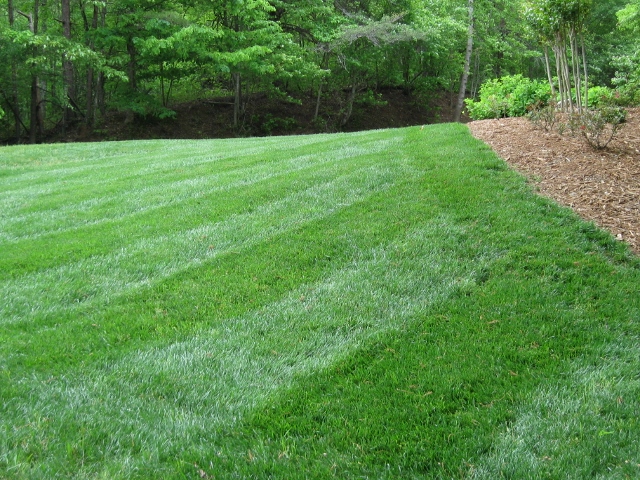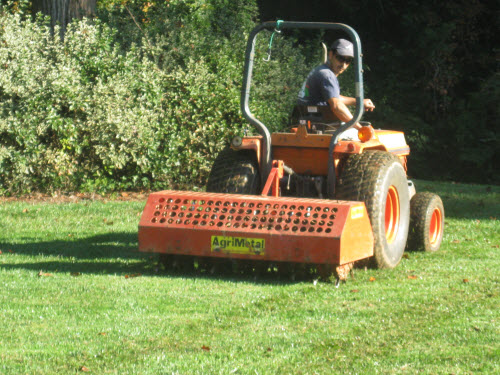|
|
FescueWinter Landscaping & Lawn Care in the South
Along with fall and winter seasons come leaf fall. LMC becomes extremely busy during late fall and early winter with blowing and collecting leaves for our clients. Leaves are collected from lawns, planting beds, and paved areas every visit during the leaf season and placed at the curbside for pick up by the City of Gainesville Solid Waste Division or we dispose of the leaves on the client’s composting/dump area. Any leaves which must be removed from site will be transported to LMC’s composting facility. Mulching: After leaf fall and the collection and disposal of leaves, LMC becomes extremely busy with applying mulch to planting beds and natural areas during the winter months. Pine straw mulch or various types of bark mulches are applied as needed. Mulch is not only utilized for aesthetics, it also benefits plant growth by retaining soil moisture, moderating changes in soil temperature, and weed suppression. Pruning: Once ‘leaf season’ is over there are many pruning tasks that must take place while or before the mulching is going on. Some of these pruning tasks that take place in mid to late winter are: Pruning trees such as raising tree canopies for mower clearance and safety; pruning crape myrtles as necessary – (LMC’s policy - we do not severe prune crape myrtles unless necessary or if they need to fit a specific space.); cutting back groundcovers such as liriope and cleaning up daylilies and spent perennials; severe pruning (‘cutting back hard’) those receptive plants to re-establish plant boundaries; pruning ornamental grasses that are so numerous in the southern landscape; and pruning landscape plants such as certain hydrangeas, roses and butterfly bushes. Seasonal Color Care: We are fortunate to have a climate that allows the installation of certain annuals that remain hardy through our winter months and then provide a beautiful spring flush of color. Installation of winter hardy annuals such as pansies, violas, snapdragons and ornamental cabbages and kales takes place in October. Inspections and care of color plantings such as applying fertilizers to encourage flower production, weed control, identification of diseases and insects, and removal of spent blooms continues throughout the winter months. Landscaping (Tree Installation) In general, LMC encourages landscaping, especially most deciduous tree installations to be done during the late fall/winter months in our area when the rate of water loss from planted trees and shrubs is much less than if installed in the spring and summer months. A fall/winter installation in our area gives the plants time to become established before the summer’s heat, humidity and water stresses set in. Landscape Management Company provides landscaping and lawn maintenance services to clients throughout North Georgia. Contact us today for more information on winter landscaping and lawn care. Posted: December 5th, 2014 | Permalink Spring Lawn Care in the SouthAdditionally, the right planting and maintenance tasks will also vary depending on the season. Here, we will outline how to choose the right turf for the South and how to care for your lawn and plants during the spring season. Turf Choosing the right turf is very important to make sure that you have grass that will survive the temperature and climate during the summer months ahead. The southern area of the country is located within the “turf transition zone.” This means that the climate allows the use of both cool season (Fescue) and warm season (Bermuda/Zoysia) grasses. However, because weather conditions can fluctuate to extremes, all turf grasses are susceptible to environmental stresses. Fescue Fescue performs and looks its best in spring and fall. Fescue lawns will naturally thin as a result of summer heat and other environmental stress so expect to see this in the summertime. Bermuda and Zoysia Bermuda and Zoysia perform and look best in late spring through early fall. These grasses are completely dormant in the winter and lose all chlorophyll which results in the turf turning a light brown color. However, they fare very well during the harsh summer months making them a good pick for southern landscapes. Spring Turf Care When it comes to spring turf care, it’s important that all winter landscape tasks are finished before the spring. Be sure to make sure that you take into consideration what tasks need to be done during the fall and winter to prepare for spring. Let’s talk about what maintenance jobs actually need to be completed during the spring season. Here are several tasks that will need to be completed. Mowing Fescue performs and grows well in the spring and should be mowed weekly at a three to four inch mowing height. This height encourages a deep root system which helps to strengthen grass. In mid to late April, you will generally start to see the warm season grasses, Bermuda and Zoysia, begin to change back from brown to green as they transition out of their winter, dormant season. This is called “greening up.” These warm season lawns should be mowed weekly and at a one to two inch mowing height during late spring and summer. Scalping Scalping is a mowing process that is done primarily on Bermuda lawns in early to mid-spring or just before the Bermuda grass starts to green up. It involves the removal of excess, dead turf leaf matter to promote grass greening up sooner by allowing sunlight to warm the soil surface. Scalping also helps to prevent thatch and is done after all chance of frost is past. Core Aeration Another spring maintenance task on warm season turf is core aeration. Aeration is performed by coring type aerators that penetrate the soil surface and remove and redeposit small columns of soil. Aeration reduces soil compaction (caused by foot traffic, mowers, etc.); improves the soil’s ability to accept oxygen, water and nutrients provided by fertilizer; enhances decomposition of grass clippings and thatch that accumulate at the soil surface. Fertilization and weed control In early spring, it’s important to apply a slow release fertilizer to fescue turf. The same should be done to warm season grasses (Bermuda and Zoysia) in late spring. All turf grasses should be treated with a weed controller in the spring as well. Landscape Service Needs All the previously mentioned landscape maintenance tasks are specific to turf care. The following are some plant maintenance tasks that should be completed during spring. Disease and Insects You should always make it a point to inspect plants for disease or insect problems such as fire ants. Check the color and condition of the leaves and the soil surrounding the plant to make sure you don’t spot any irregularities in color or any insects. Spring and Summer Flowers Mid April is the perfect time in the South to add some spring color to your lawn with spring and summer flowers. Plan your selection carefully around the most summer hardy flowers. These will perform the best and endure the drought, heat and humidity stresses of southern summers. Trees and Shrubs Early spring is a good time for installing landscape plants such as trees, shrubs and perennials. However, there needs to be sufficient watering to get these plants through the dry summer months. It's also important to to prune and maintain the plants you install. Some trees may do better installed in the fall or winter so be sure to research the type of tree you are wanting to plant to see when is the best planting season. To learn more about the services that Landscape Management Company in offers in North Georgia, please contact us today! Posted: March 20th, 2014 | Permalink How to Plant Fescue SeedFall is a great time to establish a new lawn and also the best time to rejuvenate turf that has thinned during the summer season. Aerating and over-seeding is the most common method of encouraging new plants in a fescue lawn. The first step of aerating and over-seeding is to choose the proper equipment. Aerators are the machines that are used by professionals to open up the soil to relieve compaction and most importantly when over-seeding to allow grass seed to contact the soil surface. Many times you will find that much of the successful germination occurs within the aeration hole. Always use a coring aerator with a hollow tine that removes a small column of soil rather than an aerator with solid spikes. Follow aeration by over-seeding with a quality turf type fescue seed. A “seed starter” fertilizer high in phosphorus will aid initial root development and mulching the seeds will help retain moisture. Rainfall or supplemental irrigation plus moderate temperatures will be needed for the seed to germinate. The seed should germinate within a few weeks if conditions are agreeable and if there is not signs of germination don’t give up sometimes new grass plants will peek through in early spring. For more information about the landscaping services we offer, such as our Turf Weed Control program and our Turf Care Program, contact us today! Posted: August 28th, 2012 | Permalink |



 All services offered by Landscape Management continue year -round, even though specific landscape tasks change as the seasons change. A LMC maintenance crew is scheduled to visit a client for service and inspections a minimum of every six to ten days.
All services offered by Landscape Management continue year -round, even though specific landscape tasks change as the seasons change. A LMC maintenance crew is scheduled to visit a client for service and inspections a minimum of every six to ten days.
